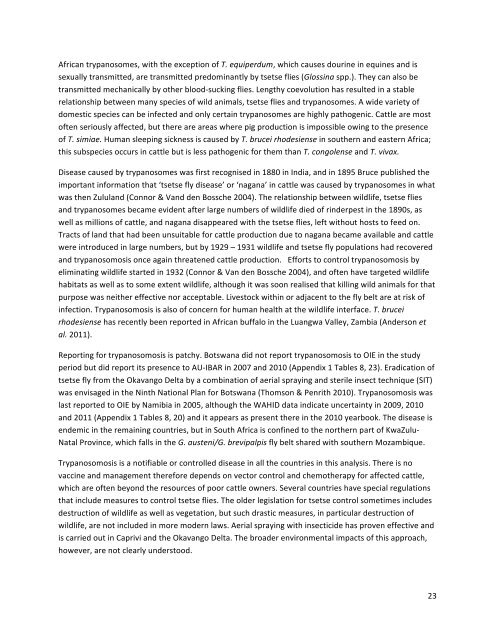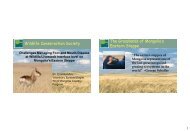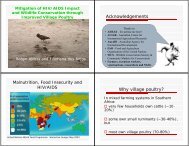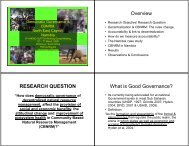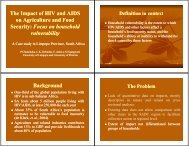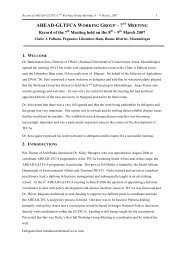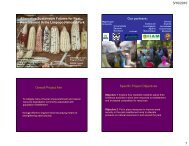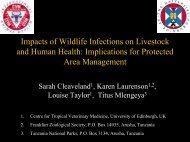Download - Animal & Human Health for the Environment and ...
Download - Animal & Human Health for the Environment and ...
Download - Animal & Human Health for the Environment and ...
You also want an ePaper? Increase the reach of your titles
YUMPU automatically turns print PDFs into web optimized ePapers that Google loves.
African trypanosomes, with <strong>the</strong> exception of T. equiperdum, which causes dourine in equines <strong>and</strong> is sexually transmitted, are transmitted predominantly by tsetse flies (Glossina spp.). They can also be transmitted mechanically by o<strong>the</strong>r blood-‐sucking flies. Lengthy coevolution has resulted in a stable relationship between many species of wild animals, tsetse flies <strong>and</strong> trypanosomes. A wide variety of domestic species can be infected <strong>and</strong> only certain trypanosomes are highly pathogenic. Cattle are most often seriously affected, but <strong>the</strong>re are areas where pig production is impossible owing to <strong>the</strong> presence of T. simiae. <strong>Human</strong> sleeping sickness is caused by T. brucei rhodesiense in sou<strong>the</strong>rn <strong>and</strong> eastern Africa; this subspecies occurs in cattle but is less pathogenic <strong>for</strong> <strong>the</strong>m than T. congolense <strong>and</strong> T. vivax. Disease caused by trypanosomes was first recognised in 1880 in India, <strong>and</strong> in 1895 Bruce published <strong>the</strong> important in<strong>for</strong>mation that ‘tsetse fly disease’ or ‘nagana’ in cattle was caused by trypanosomes in what was <strong>the</strong>n Zulul<strong>and</strong> (Connor & V<strong>and</strong> den Bossche 2004). The relationship between wildlife, tsetse flies <strong>and</strong> trypanosomes became evident after large numbers of wildlife died of rinderpest in <strong>the</strong> 1890s, as well as millions of cattle, <strong>and</strong> nagana disappeared with <strong>the</strong> tsetse flies, left without hosts to feed on. Tracts of l<strong>and</strong> that had been unsuitable <strong>for</strong> cattle production due to nagana became available <strong>and</strong> cattle were introduced in large numbers, but by 1929 – 1931 wildlife <strong>and</strong> tsetse fly populations had recovered <strong>and</strong> trypanosomosis once again threatened cattle production. Ef<strong>for</strong>ts to control trypanosomosis by eliminating wildlife started in 1932 (Connor & Van den Bossche 2004), <strong>and</strong> often have targeted wildlife habitats as well as to some extent wildlife, although it was soon realised that killing wild animals <strong>for</strong> that purpose was nei<strong>the</strong>r effective nor acceptable. Livestock within or adjacent to <strong>the</strong> fly belt are at risk of infection. Trypanosomosis is also of concern <strong>for</strong> human health at <strong>the</strong> wildlife interface. T. brucei rhodesiense has recently been reported in African buffalo in <strong>the</strong> Luangwa Valley, Zambia (Anderson et al. 2011). Reporting <strong>for</strong> trypanosomosis is patchy. Botswana did not report trypanosomosis to OIE in <strong>the</strong> study period but did report its presence to AU-‐IBAR in 2007 <strong>and</strong> 2010 (Appendix 1 Tables 8, 23). Eradication of tsetse fly from <strong>the</strong> Okavango Delta by a combination of aerial spraying <strong>and</strong> sterile insect technique (SIT) was envisaged in <strong>the</strong> Ninth National Plan <strong>for</strong> Botswana (Thomson & Penrith 2010). Trypanosomosis was last reported to OIE by Namibia in 2005, although <strong>the</strong> WAHID data indicate uncertainty in 2009, 2010 <strong>and</strong> 2011 (Appendix 1 Tables 8, 20) <strong>and</strong> it appears as present <strong>the</strong>re in <strong>the</strong> 2010 yearbook. The disease is endemic in <strong>the</strong> remaining countries, but in South Africa is confined to <strong>the</strong> nor<strong>the</strong>rn part of KwaZulu-‐Natal Province, which falls in <strong>the</strong> G. austeni/G. brevipalpis fly belt shared with sou<strong>the</strong>rn Mozambique. Trypanosomosis is a notifiable or controlled disease in all <strong>the</strong> countries in this analysis. There is no vaccine <strong>and</strong> management <strong>the</strong>re<strong>for</strong>e depends on vector control <strong>and</strong> chemo<strong>the</strong>rapy <strong>for</strong> affected cattle, which are often beyond <strong>the</strong> resources of poor cattle owners. Several countries have special regulations that include measures to control tsetse flies. The older legislation <strong>for</strong> tsetse control sometimes includes destruction of wildlife as well as vegetation, but such drastic measures, in particular destruction of wildlife, are not included in more modern laws. Aerial spraying with insecticide has proven effective <strong>and</strong> is carried out in Caprivi <strong>and</strong> <strong>the</strong> Okavango Delta. The broader environmental impacts of this approach, however, are not clearly understood. 23


